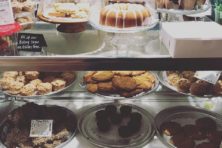My Gluten-free Week
- Share
- Tweet
- Pin
- Share
Almost two years ago my girlfriend committed to a wheat-less life and switched to a gluten-free diet after years of stomach problems. She wasn’t formally diagnosed with celiac disease (the test is expensive), but after dozens of tests, doctor visits, eliminating gluten was her most effective treatment.
In early July, I finally responded to her challenge to try going gluten-free for just a week. She didn’t think I could. Honestly, neither did I.
I thought I was sympathetic to my girlfriend’s plight, but scouring a restaurant menu in search of something I could order that carried no gluten risk opened my eyes to a whole new level of dining frustration. Very few dishes are available without modification. When I ordered (a burger with no bun, for instance) I found myself feeling insecure, like less of a man for turning down the bread. I also felt the urge to explain that I wasn’t on a low-carb diet, that it was just a challenge.
But at least I didn’t have to worry about the side effects of eating gluten as celiac sufferers do. Those with the disease can process no more than 30 milligrams of gluten each day. That’s about a teaspoon of cake or, in other words, nothing. That means they have to be assured there will be no cross-contamination in food preparation, as the slightest trace can cause a reaction in many sufferers.
How many of us who have worked in a restaurant (I spent 12 years in them) would have total confidence in a busy kitchen to do that?
My week without wheat wasn’t all bad. It was also a week without cookies or donuts, two of my weaknesses. I felt less full (thought at times starving was a better word), leaner, and healthier. Of course, I was cognizant of the fact that I had day eight to look forward to – a glorious day when bread, cookies, and granola would once again be an option.
But that glorious day doesn’t come for those with celiac disease. It’s not a mere wheat allergy, as many believe, but rather an autoimmune disease, like Type 1 diabetes or multiple sclerosis. It is genetic and triggered by gluten, which is mismanaged by the body in those with the genetic makeup. A mere wheat allergy may be outgrown. Pam King, Director of Operations for the University of Maryland Center for Celiac Research, explained a more important difference.
“With celiac disease,” King said, “you’re actually doing damage to your intestines that can lead to intestinal lymphoma. A wheat allergy won’t do that.”
The mention of lymphoma is scary, but the effects are reversible if a patient follows a strict gluten-free diet, the only treatment for the disease.
So when a restaurant customer asks detailed questions about how their food will be prepared, they’re not always being a pain. Recognizing how serious the side effects can be makes me want to go back in time and slap my old, naïve self for the eyerolls I gave many a “picky” customer or my waitresses, when they came back to the kitchen window with a special request.
Those requests are becoming more common. Though some of that is owed to the low-carb diet craze, much is owed to a surge in celiac science.
In 2003, King’s office, led by Dr. Allesio Fesano, published a landmark study that revealed a much higher incidence of celiac disease than previously thought. Once thought to affect about one in 10,000 people, the study showed that at least 1 of every 200 people (about 0.7 percent of the population) are thought to have the disease, but many are undiagnosed. Dr. Fassano said it took a lot of education to convince the medical community to start considering the disease in their practices.
“There was certainly skepticism in the scientific community,” he said. “Many thought we were wasting our time in researching it. They said it didn’t exist.”
There are now 110,000 diagnosed celiac cases in the U.S., up from 40,000 just six years ago. King said the study changed the way the disease is viewed. It was long considered a child’s disease and people didn’t realize it could be present in adults, King said.
Like any disease, individual symptoms vary, but bloating and abdominal pain are common indicators. Unfortunately, celiac symptoms are also signs of many ailments, and a blood test and a biopsy of the intestine are necessary for a final diagnosis.
Though it may seem that a simple trial run of a gluten-free diet is a good way to self-diagnose, King said it’s not recommended. Dr. Phil Arnold of North Shore Medical Clinic explained why that could be problematic.
He pointed to how prevalent gluten has become in the American diet. Most fast food and processed food contains gluten. If one goes gluten-free, all those processed foods are eliminated and tend to be replaced by real, wholesome foods. For instance, in my week, I found myself ditching bread, cookies, and snack bars for yogurt, apples, and bananas.
“So the question becomes, is it the gluten, or is it all the sugar and preservatives that were causing the problem?” Arnold asked. “It’s difficult to assign everything to gluten without a test. In general, it’s better for every aspect of your health to eat healthy.”
A dietary change can confuse or mask the real issue. But the cost of the tests required for diagnosis is enough to make many folks ditch that warning. Without insurance, King said the two steps cost at least $1,400, and a quote received from Bellin Hospital in Green Bay put the minimum cost without pathology at $2,154.
Fortunately, I don’t have symptoms that would necessitate that test. If I did, I would have been hurting in my gluten-free week.
I slipped up four times. Three were accidents, one in which I ate a bowl of oatmeal without checking the label, and another came when I devoured a Cliff Bar in desperation on a long bike ride. The third was when I made myself a wrap instead of a sandwich to avoid the bread, before realizing there was gluten in the tortilla. I should have seen that one coming; it was a whole-wheat tortilla, after all.
The fourth time I just plain cheated. I stared down my buddy’s pepperjack sticks on the bar for a couple minutes on day number six before the call of the breaded grease grew too loud for this Wisconsin blood to ignore.
The rest of the week I held out, even when staring down that full loaf of bread in my cabinet, or the cookies in the deli, and the still-warm bakery.
When my experiment began, I looked forward to a return to my bread-munching ways, but after a few days I found myself liking the way I felt. I don’t plan on going sans bread, but even for a relatively healthy young man, the week underscored the difference a healthier diet can make.
Not Just Bread
Many products contain “hidden” gluten, such as:
Soy sauce
Teriyaki sauce
Beer
Cream sauces (often made with a flour-based rue)
Some baked beans
Some sausages
Meat stock cubes
Licorice
White pepper
For more information visit http://www.celiac.org or http://www.celiaccenter.org.


